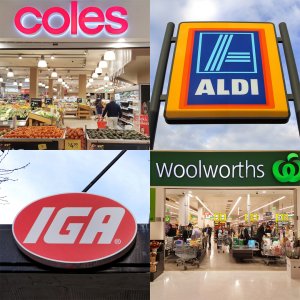Are you overpaying? An expert reveals sneaky supermarket tactics inflating your bill!
- Replies 18
When it comes to grocery shopping, we're all desperately watching our dollars. We all understand how precious every penny is and how vital it is to ensure we get the best deals.
But do you ever feel like you're not making the most of your money? Like there may be something ‘fishy’ going on at the supermarket? Well, a recent warning issued by a marketing expert has unveiled the tactics used by supermarkets as a way of making us spend more money whenever we walk into the store.
Professor Nitika Garg from the School of Marketing at UNSW Business School said supermarkets are taking advantage of consumers who don't always have the time for multi-store shopping.
‘With the cost-of-living crisis soaring, it would be in the interest of consumers to shop at different stores to get the best deals, if they have the time,’ she said.
‘You could go to one shop to get your meat and then another to get your veggies because you as a consumer have taken the time to research and know where the best and cheapest products are.’
However, as we all know, not everyone has the time or mobility to do their weekly grocery shopping at more than one store, and as a result, the supermarkets take advantage of those very people.
‘A lot of the tactics are based on getting the consumer in, because once they're in, they will likely end up buying a lot more than they expected,’ Professor Garg explained.
So, what exactly are these tactics? Let's take a closer look.
One is what's referred to as the 'loss leader' concept. This is where supermarkets tempt us with 'attractive deals' to make us enter the store and, in the process, do a whole lot more shopping.
Another potentially sneaky tactic could be the 'locked-in deal'. This is when a supermarket advertises a capped price on products which, in some cases, may be the same as the original price. It's a smart way to make us feel like we're getting a bargain when in reality, this deal may not be as generous as it first appears.
Other tricks put in place are something as simple as the layout of the supermarket. This is why you'll frequently see 'staple' products such as milk or bread at the back of the store or other items strategically placed in areas where customers have to spend more time looking around. Now I know why it’s always so hard to find where the milk, bread, and eggs are!
A report from UNSW also pointed out that supermarkets use 'calming' music to try and keep customers in the store for longer. It may be subtle, but it does make a difference.
'Buy two for the price of one' or 'buy two and get one free' deals are also common, but shoppers have been warned to be especially careful of these when it comes to items with shorter expiry dates.

Finally, Professor Garg warned shoppers to be aware of these in-store and online tactics.
'If consumers are more aware of these tactics, they can be more mindful of where they want to rely on these and where they want to be wary of such tactics,' she said.
By keeping these tips in mind, we can all make sure we’re getting the best bang for our buck on our next shopping trip, and hopefully, we can all save some of our hard-earned dollars. So, what did you think of these supermarket tactics? Were you aware of them before reading this article? Tell us in the comments section below!
But do you ever feel like you're not making the most of your money? Like there may be something ‘fishy’ going on at the supermarket? Well, a recent warning issued by a marketing expert has unveiled the tactics used by supermarkets as a way of making us spend more money whenever we walk into the store.
Professor Nitika Garg from the School of Marketing at UNSW Business School said supermarkets are taking advantage of consumers who don't always have the time for multi-store shopping.
‘With the cost-of-living crisis soaring, it would be in the interest of consumers to shop at different stores to get the best deals, if they have the time,’ she said.
‘You could go to one shop to get your meat and then another to get your veggies because you as a consumer have taken the time to research and know where the best and cheapest products are.’
However, as we all know, not everyone has the time or mobility to do their weekly grocery shopping at more than one store, and as a result, the supermarkets take advantage of those very people.
‘A lot of the tactics are based on getting the consumer in, because once they're in, they will likely end up buying a lot more than they expected,’ Professor Garg explained.
So, what exactly are these tactics? Let's take a closer look.
One is what's referred to as the 'loss leader' concept. This is where supermarkets tempt us with 'attractive deals' to make us enter the store and, in the process, do a whole lot more shopping.
Another potentially sneaky tactic could be the 'locked-in deal'. This is when a supermarket advertises a capped price on products which, in some cases, may be the same as the original price. It's a smart way to make us feel like we're getting a bargain when in reality, this deal may not be as generous as it first appears.
Other tricks put in place are something as simple as the layout of the supermarket. This is why you'll frequently see 'staple' products such as milk or bread at the back of the store or other items strategically placed in areas where customers have to spend more time looking around. Now I know why it’s always so hard to find where the milk, bread, and eggs are!
A report from UNSW also pointed out that supermarkets use 'calming' music to try and keep customers in the store for longer. It may be subtle, but it does make a difference.
'Buy two for the price of one' or 'buy two and get one free' deals are also common, but shoppers have been warned to be especially careful of these when it comes to items with shorter expiry dates.
Key Takeaways
- Marketing expert Professor Nitika Garg is warning shoppers about supermarket tactics that can prompt increased spending, such as product 'cues' and the 'loss leader' concept.
- Supermarket layouts, larger trolleys, and even calming music selections are also employed as strategies to encourage customers to spend more time in stores and, subsequently, purchase more products.
- Special offers, such as 'buy two get one free' or 'two for the price of one', can often be misleading, particularly for items with a short shelf life.
- It's not only in-store shopping that uses these tactics; online shoppers should also be aware of similar strategies being used on them.
Finally, Professor Garg warned shoppers to be aware of these in-store and online tactics.
'If consumers are more aware of these tactics, they can be more mindful of where they want to rely on these and where they want to be wary of such tactics,' she said.
By keeping these tips in mind, we can all make sure we’re getting the best bang for our buck on our next shopping trip, and hopefully, we can all save some of our hard-earned dollars. So, what did you think of these supermarket tactics? Were you aware of them before reading this article? Tell us in the comments section below!








